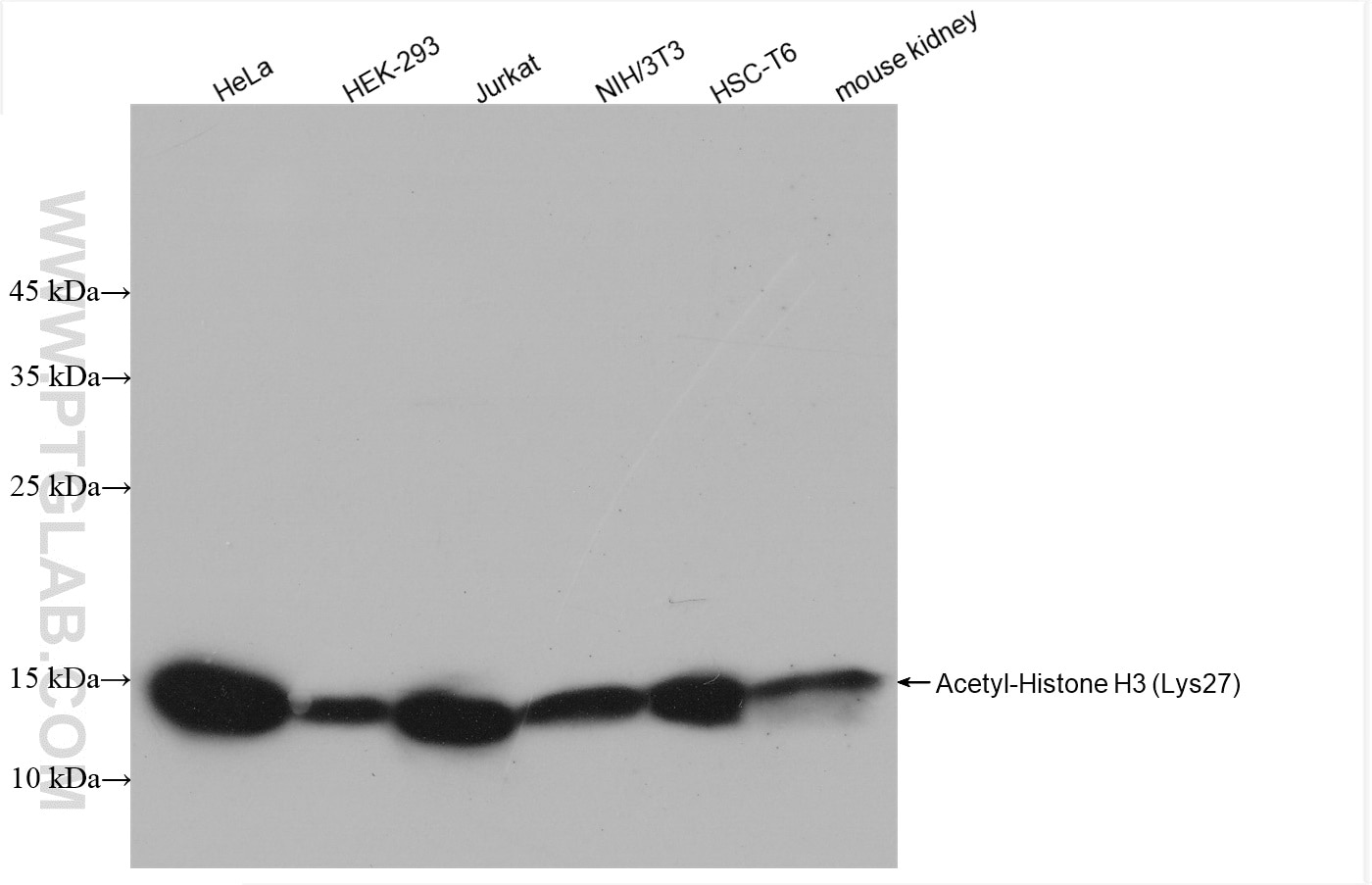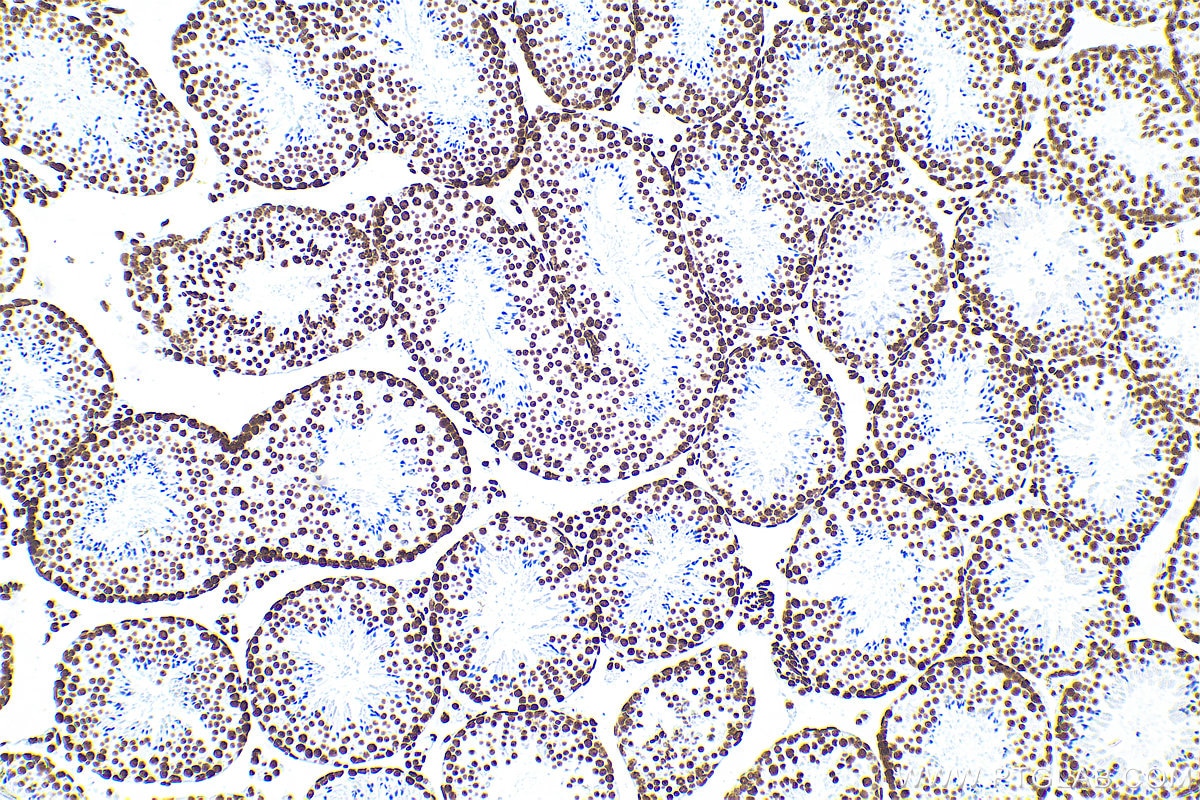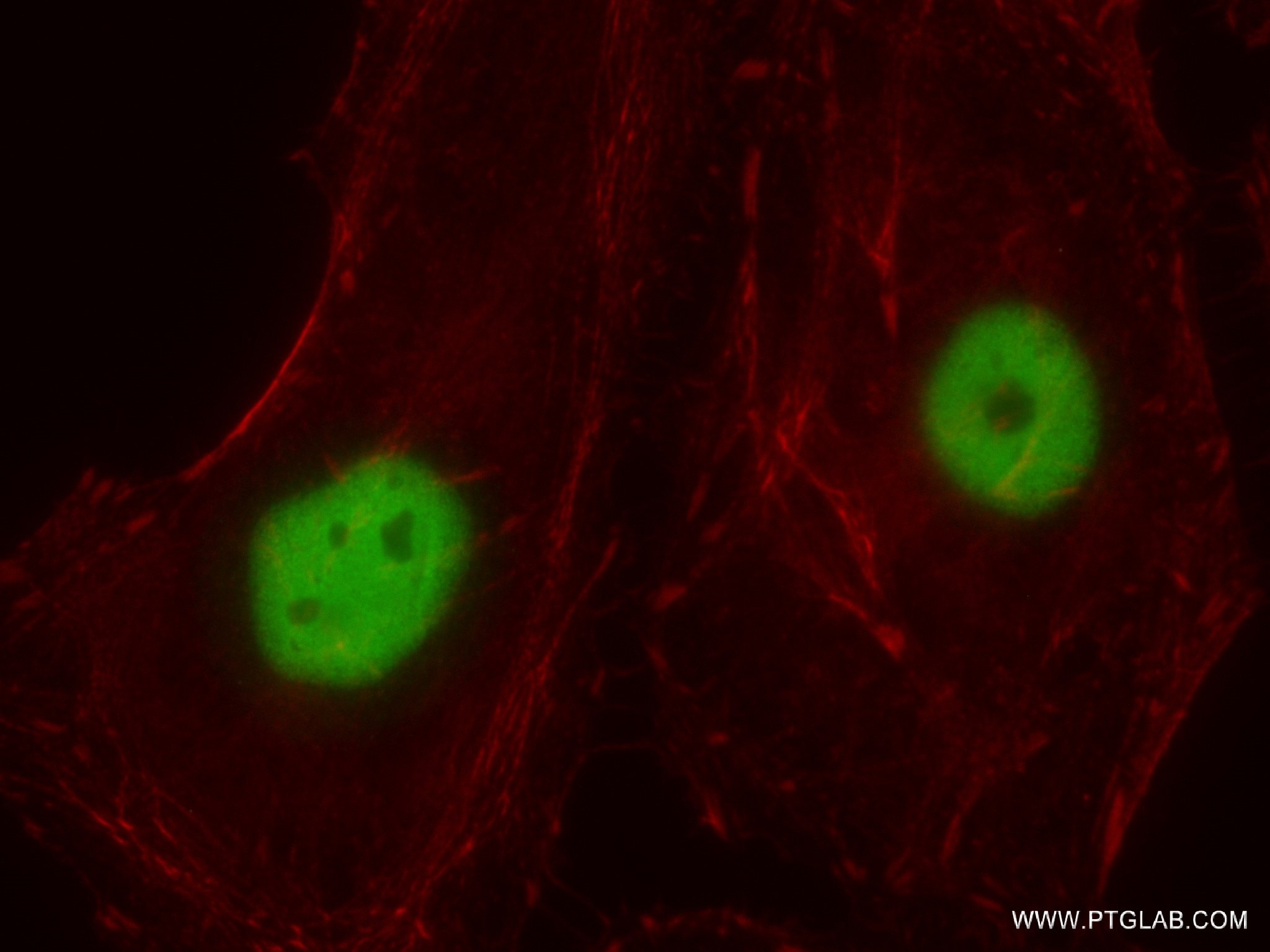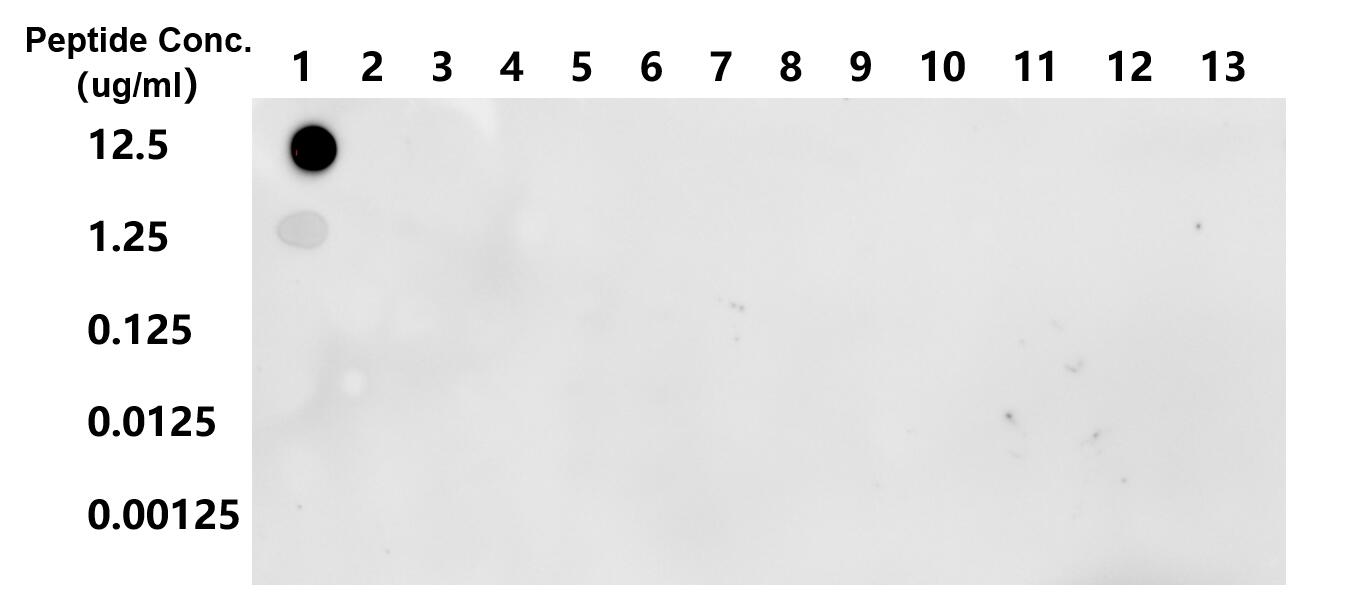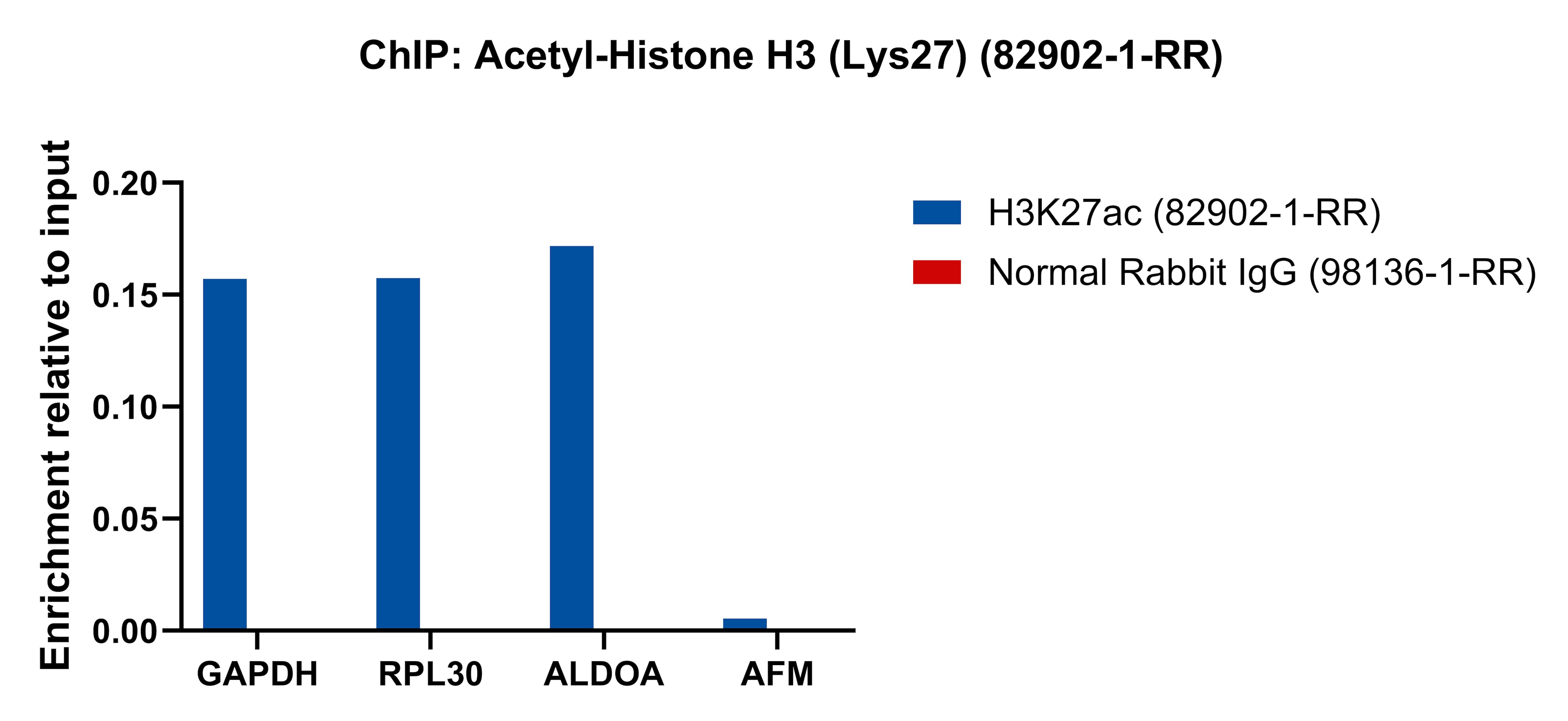Anticorps Recombinant de lapin anti-Acetyl-Histone H3 (Lys27)
Acetyl-Histone H3 (Lys27) Recombinant Antibody for WB, IHC, IF/ICC, Dot Blot, ELISA, ChIP-qPCR
Hôte / Isotype
Lapin / IgG
Réactivité testée
Humain, rat, souris
Applications
WB, IHC, IF/ICC, Dot Blot, ELISA, ChIP-qPCR
Conjugaison
Non conjugué
CloneNo.
1M16
N° de cat : 82902-1-RR
Synonymes
Galerie de données de validation
Applications testées
| Résultats positifs en WB | cellules HeLa, cellules HEK-293, cellules HSC-T6, cellules Jurkat, cellules NIH/3T3, tissu rénal de souris |
| Résultats positifs en IHC | tissu testiculaire de souris, il est suggéré de démasquer l'antigène avec un tampon de TE buffer pH 9.0; (*) À défaut, 'le démasquage de l'antigène peut être 'effectué avec un tampon citrate pH 6,0. |
| Résultats positifs en IF/ICC | cellules HeLa, |
| Résultats positifs en Dot Blot | Peptide, |
| Résultats positifs en ChIP-qPCR | cellules HeLa, |
Dilution recommandée
| Application | Dilution |
|---|---|
| Western Blot (WB) | WB : 1:2000-1:19600 |
| Immunohistochimie (IHC) | IHC : 1:1000-1:4000 |
| Immunofluorescence (IF)/ICC | IF/ICC : 1:200-1:800 |
| DOT BLOT | DOT BLOT : 1:10-1:100 |
| CHImmunoprécipitation (IP)-QPCR | CHIP-QPCR : 1:10-1:100 |
| It is recommended that this reagent should be titrated in each testing system to obtain optimal results. | |
| Sample-dependent, check data in validation data gallery | |
Applications publiées
| WB | See 2 publications below |
Informations sur le produit
82902-1-RR cible Acetyl-Histone H3 (Lys27) dans les applications de WB, IHC, IF/ICC, Dot Blot, ELISA, ChIP-qPCR et montre une réactivité avec des échantillons Humain, rat, souris
| Réactivité | Humain, rat, souris |
| Réactivité citée | rat, Humain, souris |
| Hôte / Isotype | Lapin / IgG |
| Clonalité | Recombinant |
| Type | Anticorps |
| Immunogène | Peptide |
| Nom complet | histone cluster 1, H3a |
| Poids moléculaire observé | 15 kDa |
| Numéro d’acquisition GenBank | BC066245 |
| Symbole du gène | HIST1H3A |
| Identification du gène (NCBI) | 8350 |
| Conjugaison | Non conjugué |
| Forme | Liquide |
| Méthode de purification | Purification par protéine A |
| Tampon de stockage | PBS with 0.02% sodium azide and 50% glycerol |
| Conditions de stockage | Stocker à -20°C. Stable pendant un an après l'expédition. L'aliquotage n'est pas nécessaire pour le stockage à -20oC Les 20ul contiennent 0,1% de BSA. |
Informations générales
Histones are small, highly basic proteins that consist of a globular domain with unstructured N- and C-terminal tails protruding from the main structure. Histone H3 is one of the five main histones that are responsible for the nucleosome structure of the chromosomal fiber in eukaryotes. Two molecules of each of the four core histones (H2A, H2B, H3, and H4) form an octamer, around which approximately 146 bp of DNA is wrapped in repeating units, called nucleosomes. In addition to their role in DNA compartmentalization, histones also play crucial roles in various biologic processes, including gene expression and regulation, DNA repair, chromatin condensation, cell cycle progression, chromosome segregation, and apoptosis. The ability of histones to regulate chromatin dynamics primarily originates from various posttranslational modifications carried out by histone-modifying enzymes. Acetyl-Histone H3 (Lys27) is enhancer specific mark and plays positive role in gene expression.
Protocole
| Product Specific Protocols | |
|---|---|
| WB protocol for Acetyl-Histone H3 (Lys27) antibody 82902-1-RR | Download protocol |
| IHC protocol for Acetyl-Histone H3 (Lys27) antibody 82902-1-RR | Download protocol |
| IF protocol for Acetyl-Histone H3 (Lys27) antibody 82902-1-RR | Download protocol |
| Standard Protocols | |
|---|---|
| Click here to view our Standard Protocols |
Publications
| Species | Application | Title |
|---|---|---|
J Med Chem Discovery of Novel Imidazo[1,2-a]pyridine-Based HDAC6 Inhibitors as an Anticarcinogen with a Cardioprotective Effect | ||
Cell Death Discov The dual HDAC/PI3K inhibitor CUDC-907 inhibits the growth and proliferation of MYC-driven Group 3 medulloblastoma |
